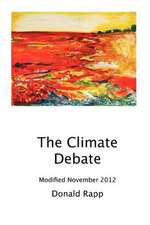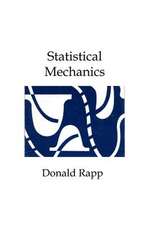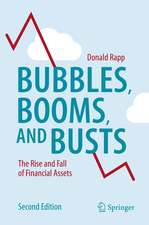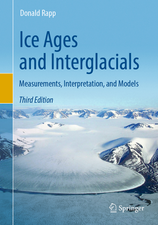Human Missions to Mars: Enabling Technologies for Exploring the Red Planet: Springer Praxis Books
Autor Donald Rappen Limba Engleză Paperback – 23 aug 2016
ultimate goal of planetary exploration since the 1950s, when von Braun
conjectured a flotilla of 10 interplanetary vessels carrying a crew of at
least 70 humans. Since then, more than 1,000 studies were carried out
on human missions to Mars, but after 60 years of study, we remain in the
early planning stages. The second edition of this book now includes an annotated history of Mars mission studies, with quantitative data wherever
possible.
Retained from the first edition, Donald Rapp looks at human missions
to Mars from an engineering perspective. He divides the mission into a
number of stages: Earth’s surface to low-Earth orbit (LEO); departing from
LEO toward Mars; Mars orbit insertion and entry, descent and landing; ascent from Mars; trans-Earth injection from Mars orbit and Earth return.
For each segment, he analyzes requirements for candidate technologies.
In this connection, he discusses the status and potential of a wide range
of elements critical to a human Mars mission, including life support
consumables, radiation effects and shielding, microgravity effects, abort
options and mission safety, possible habitats on the Martian surface and aero-assisted orbit entry decent and landing. For any human mission to
the Red Planet the possible utilization of any resources indigenous to
Mars would be of great value and such possibilities, the use of indigenous
resources is discussed at length. He also discusses the relationship of lunar
exploratio
n to Mars exploration. Detailed appendices describe the availability of solar energy on the Moon
and Mars, and the potential for utilizing indigenous water on Mars.
The second edition provides extensive updating and additions to the first
edition, including many new figures and tables, and more than 70 new
references, as of 2015.
| Toate formatele și edițiile | Preț | Express |
|---|---|---|
| Paperback (3) | 702.40 lei 38-44 zile | |
| Springer International Publishing – 3 ian 2024 | 702.40 lei 38-44 zile | |
| Springer Berlin, Heidelberg – 19 noi 2010 | 1123.98 lei 6-8 săpt. | |
| Springer International Publishing – 23 aug 2016 | 1395.00 lei 6-8 săpt. | |
| Hardback (1) | 922.66 lei 38-44 zile | |
| Springer International Publishing – 2 ian 2023 | 922.66 lei 38-44 zile |
Din seria Springer Praxis Books
-
 Preț: 294.46 lei
Preț: 294.46 lei -
 Preț: 223.45 lei
Preț: 223.45 lei -
 Preț: 193.12 lei
Preț: 193.12 lei -
 Preț: 167.85 lei
Preț: 167.85 lei -
 Preț: 288.98 lei
Preț: 288.98 lei -
 Preț: 323.74 lei
Preț: 323.74 lei -
 Preț: 376.08 lei
Preț: 376.08 lei -
 Preț: 264.12 lei
Preț: 264.12 lei - 8%
 Preț: 517.61 lei
Preț: 517.61 lei -
 Preț: 190.01 lei
Preț: 190.01 lei -
 Preț: 218.16 lei
Preț: 218.16 lei -
 Preț: 312.06 lei
Preț: 312.06 lei - 17%
 Preț: 401.17 lei
Preț: 401.17 lei -
 Preț: 216.41 lei
Preț: 216.41 lei -
 Preț: 262.27 lei
Preț: 262.27 lei -
 Preț: 264.35 lei
Preț: 264.35 lei -
 Preț: 167.63 lei
Preț: 167.63 lei -
 Preț: 259.52 lei
Preț: 259.52 lei -
 Preț: 259.08 lei
Preț: 259.08 lei -
 Preț: 305.47 lei
Preț: 305.47 lei -
 Preț: 234.01 lei
Preț: 234.01 lei -
 Preț: 227.85 lei
Preț: 227.85 lei -
 Preț: 259.95 lei
Preț: 259.95 lei -
 Preț: 295.56 lei
Preț: 295.56 lei -
 Preț: 357.17 lei
Preț: 357.17 lei -
 Preț: 275.79 lei
Preț: 275.79 lei -
 Preț: 257.08 lei
Preț: 257.08 lei -
 Preț: 349.71 lei
Preț: 349.71 lei -
 Preț: 272.45 lei
Preț: 272.45 lei -
 Preț: 270.27 lei
Preț: 270.27 lei - 8%
 Preț: 433.24 lei
Preț: 433.24 lei -
 Preț: 327.03 lei
Preț: 327.03 lei - 8%
 Preț: 394.80 lei
Preț: 394.80 lei -
 Preț: 320.65 lei
Preț: 320.65 lei -
 Preț: 325.29 lei
Preț: 325.29 lei -
 Preț: 253.11 lei
Preț: 253.11 lei -
 Preț: 192.86 lei
Preț: 192.86 lei -
 Preț: 313.40 lei
Preț: 313.40 lei -
 Preț: 150.51 lei
Preț: 150.51 lei -
 Preț: 233.34 lei
Preț: 233.34 lei -
 Preț: 286.78 lei
Preț: 286.78 lei -
 Preț: 212.01 lei
Preț: 212.01 lei -
 Preț: 366.83 lei
Preț: 366.83 lei -
 Preț: 274.68 lei
Preț: 274.68 lei -
 Preț: 232.27 lei
Preț: 232.27 lei -
 Preț: 284.58 lei
Preț: 284.58 lei -
 Preț: 212.45 lei
Preț: 212.45 lei -
 Preț: 159.81 lei
Preț: 159.81 lei -
 Preț: 349.48 lei
Preț: 349.48 lei - 20%
 Preț: 2061.61 lei
Preț: 2061.61 lei
Preț: 1395.00 lei
Preț vechi: 1701.22 lei
-18% Nou
Puncte Express: 2093
Preț estimativ în valută:
266.96€ • 277.02$ • 223.14£
266.96€ • 277.02$ • 223.14£
Carte tipărită la comandă
Livrare economică 17-31 martie
Preluare comenzi: 021 569.72.76
Specificații
ISBN-13: 9783319330921
ISBN-10: 3319330926
Pagini: 582
Ilustrații: XXVIII, 582 p. 188 illus., 124 illus. in color.
Dimensiuni: 155 x 235 mm
Greutate: 0.84 kg
Ediția:Softcover reprint of the original 2nd ed. 2016
Editura: Springer International Publishing
Colecția Springer
Seriile Springer Praxis Books, Astronautical Engineering
Locul publicării:Cham, Switzerland
ISBN-10: 3319330926
Pagini: 582
Ilustrații: XXVIII, 582 p. 188 illus., 124 illus. in color.
Dimensiuni: 155 x 235 mm
Greutate: 0.84 kg
Ediția:Softcover reprint of the original 2nd ed. 2016
Editura: Springer International Publishing
Colecția Springer
Seriile Springer Praxis Books, Astronautical Engineering
Locul publicării:Cham, Switzerland
Cuprins
Why Explore Mars?.- Planning Space Campaigns and Missions.- 60+ Years of Humans to Mars Mission Planning.- Getting There and Back.- Critical Mars Mission Elements.- In Situ Utilization of Indigenous Resources.- Why the NASA approach will likely fail to send humans to Mars for many decades to come.
Recenzii
“This second edition of Donald Rapp’s book is an impressive, comprehensive, and well-organized work that begins by exploring the history of the planning of human flights to Mars. ... There are three very comprehensive Appendices, which derive full statistical data for collecting solar energy on the Moon and Mars, and the quantities of water to be found on Mars at different localities (including a discussion of the topical ‘slope lineae’). A Glossary completes the text.” (Richard McKim, The Observatory, Vol. 136 (1253), August, 2016)
Textul de pe ultima copertă
A mission to send humans to explore the surface of Mars has been theultimate goal of planetary exploration since the 1950s, when von Braun envisaged a flotilla of 10 interplanetary vessels carrying a crew of at least 70 humans. Since then, more than 1,000 studies have been carried out on human missions to Mars, but after 60 years of study, we remain in the early planning stages. The second edition of this book now includes an annotated history of Mars mission studies, with quantitative data wherever possible.
As in the first edition, Donald Rapp looks at human missions to Mars from an engineering perspective. He divides each mission into a number of stages: Earth’s surface to low-Earth orbit (LEO); departing from LEO toward Mars; Mars orbit insertion and entry, descent and landing; ascent from Mars; trans-Earth injection from Mars orbit; and Earth return. For each segment, he analyzes requirements for candidate technologies. In this connection, he discusses the status and potential of a wide range of elements critical to a human Mars mission, including life support consumables, radiation effects and shielding, microgravity effects, abort options and mission safety, possible habitats on the Martian surface and aero-assisted orbit entry descent and landing. For any human mission to the Red Planet the possible utilization of any resources indigenous to Mars would be of great value; such possibilities are discussed at length. He also discusses the relationship of lunar exploration to Mars exploration.
Detailed appendices describe the availability of solar energy on the Moon and Mars, and the potential for utilizing indigenous water on Mars.The second edition provides extensive updating and additions to the first edition, including many new figures and tables, and more than 70 new references, as of 2015.
As in the first edition, Donald Rapp looks at human missions to Mars from an engineering perspective. He divides each mission into a number of stages: Earth’s surface to low-Earth orbit (LEO); departing from LEO toward Mars; Mars orbit insertion and entry, descent and landing; ascent from Mars; trans-Earth injection from Mars orbit; and Earth return. For each segment, he analyzes requirements for candidate technologies. In this connection, he discusses the status and potential of a wide range of elements critical to a human Mars mission, including life support consumables, radiation effects and shielding, microgravity effects, abort options and mission safety, possible habitats on the Martian surface and aero-assisted orbit entry descent and landing. For any human mission to the Red Planet the possible utilization of any resources indigenous to Mars would be of great value; such possibilities are discussed at length. He also discusses the relationship of lunar exploration to Mars exploration.
Detailed appendices describe the availability of solar energy on the Moon and Mars, and the potential for utilizing indigenous water on Mars.The second edition provides extensive updating and additions to the first edition, including many new figures and tables, and more than 70 new references, as of 2015.
Caracteristici
Offers a highly readable yet realistic view of the possibilities for human missions to Mars Provides for the first time a ‘level-headed’ assessment of plans for human exploration of Mars to counteract the tendency of space agencies to take an over-optimistic approach to such interplanetary missions Collects together into a single, handy reference, a wide range of material on human missions to Mars that is currently widely dispersed and fragmented in the literature Describes in detail the requirements and characteristics of human missions to Mars and assesses current space agency plans in the light of such requirements Contains a large number of black and white and colour illustrations and line diagrams illustrating the many practical aspects of planning and executing human missions to Mars Details the history of planning Mars missions, the technologies needed, the mission concepts, and NASA activities. It also provides details on solar energy and water availability Includes supplementary material: sn.pub/extras
Notă biografică
Donald Rapp was full professor of physics at the University of Texas 1969-1979, and Chief Technologist of the Mechanical and Chemical Engineering Division of JPL from 1979 to 2002.
He was manager of the Mars Exploration Technology Program at JPL for a period, and he was manager of the In Situ Propellant Production (ISPP) task in this Program. He wrote a landmark report on converting Mars resources into usable propellants for return to Earth. He wrote the Mars Technology Program Plan in 2001.
He was proposal manager at JPL for two missions that were implemented in space: Suess-Urey mission to collect solar wind, and Deep Impact to observe interior of a comet.
During the period 2001-2002, he played an important role in JPL efforts in developing concepts for utilization of extraterrestrial resources in Mars missions. In 2002 he wrote the NASA Office of Space Science Technology Blueprint for Harley Thronson, NASA Technology Director, a 100-page assessment of technology needs and capabilities for future missions.
In the period 2003-2006, he prepared a revised and expanded version of the Technology Blueprint for Harley Thronson at NASA HQ. In 2004, he was Proposal Manager for a proposal for a ground-penetrating radar experiment for the Mars Science Laboratory as well as a glider mission on Mars.
In the period 2004-2006, he concentrated on mission design for Mars and lunar human missions. This work led to his writing the book Human Missions to Mars that was published by Praxis/Springer in 2007. This was a major work, comprising 520 pages with over 200 figures. It included a chapter on in situ resource utilization (ISRU) on Mars.
He was the lead person at JPL for ISRU technology for several decades. In this role, he carried out research and analysis leading to a number or reports and publications through the 1980s, 1990s and into the 2000s.
Since 2014, he has been Co-Investigator on the Mars OXygen In Situ Experiment(MOXIE) that operated on Mars in 2021-022 to routinely produce oxygen from Martian carbon dioxide.
The original book Human Missions to Mars was updated to a second edition in 2015, and is now presented as a third edition in 2022 with many new references and updates.
He was manager of the Mars Exploration Technology Program at JPL for a period, and he was manager of the In Situ Propellant Production (ISPP) task in this Program. He wrote a landmark report on converting Mars resources into usable propellants for return to Earth. He wrote the Mars Technology Program Plan in 2001.
He was proposal manager at JPL for two missions that were implemented in space: Suess-Urey mission to collect solar wind, and Deep Impact to observe interior of a comet.
During the period 2001-2002, he played an important role in JPL efforts in developing concepts for utilization of extraterrestrial resources in Mars missions. In 2002 he wrote the NASA Office of Space Science Technology Blueprint for Harley Thronson, NASA Technology Director, a 100-page assessment of technology needs and capabilities for future missions.
In the period 2003-2006, he prepared a revised and expanded version of the Technology Blueprint for Harley Thronson at NASA HQ. In 2004, he was Proposal Manager for a proposal for a ground-penetrating radar experiment for the Mars Science Laboratory as well as a glider mission on Mars.
In the period 2004-2006, he concentrated on mission design for Mars and lunar human missions. This work led to his writing the book Human Missions to Mars that was published by Praxis/Springer in 2007. This was a major work, comprising 520 pages with over 200 figures. It included a chapter on in situ resource utilization (ISRU) on Mars.
He was the lead person at JPL for ISRU technology for several decades. In this role, he carried out research and analysis leading to a number or reports and publications through the 1980s, 1990s and into the 2000s.
Since 2014, he has been Co-Investigator on the Mars OXygen In Situ Experiment(MOXIE) that operated on Mars in 2021-022 to routinely produce oxygen from Martian carbon dioxide.
The original book Human Missions to Mars was updated to a second edition in 2015, and is now presented as a third edition in 2022 with many new references and updates.

















